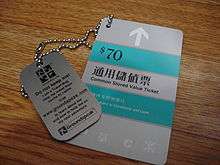Common stored value ticket
A common stored value ticket was a plastic magnetically sensitive card used for paying fares on the MTR and KCR railway systems in Hong Kong[1] from 1984 to 1999. It was also used on Citybus and Kowloon Motor Bus for some MTR and KCR feeder bus services. The system was replaced by the Octopus card system in 1997 and phased out on 2 January 1999. The MTR and KCR have continued to issue magnetic strip cards for single-journey and souvenir tickets.

To encourage use, fares had a discount when the trip was paid by this card. In addition, higher value tickets had bonus value stored when purchased. (For example, a $200 ticket bought in early 1990s had a stored value of $212, while it still only cost $200 to purchase). To avoid the issue of making up fare for a trip with insufficient balance remaining on the ticket, it was stipulated that the last trip of the ticket was good for any distance on the railway, regardless of remaining balance on the ticket. Thus, it was possible to travel for the entire distance of the system with a stored vale ticket with ten Hong Kong cents (approximately US 1.5 cents) remaining on the ticket.
History
In 1981, MTR Corporation started using magnetic strip cards as tickets. The turnstile would confiscate the ticket when the passenger leaves the subway system.
On 15 October 1984, KCR automated its ticketing system. The two companies jointly produced the common stored value ticket.
On 31 August 1998, MTR and KCR announced that the tickets were no longer to be sold. They would be replaced by the Octopus card starting on 2 January 1999.
References
- Wallis, Ian (2013). 50 Best Business Ideas That Changed the World. Jaico Publishing House. p. 347. ISBN 9788184952841.